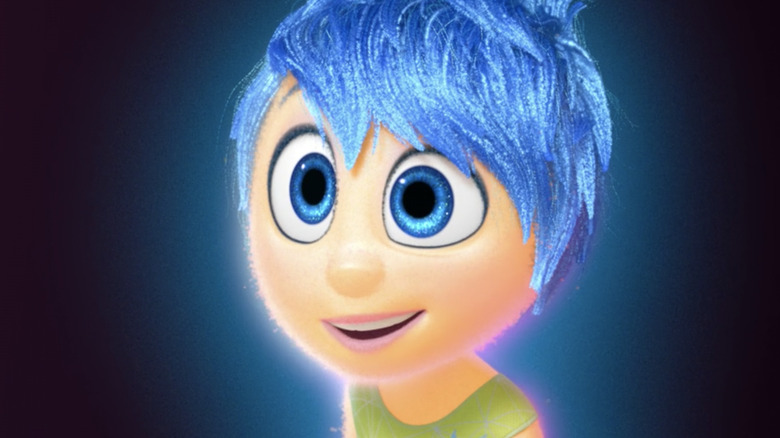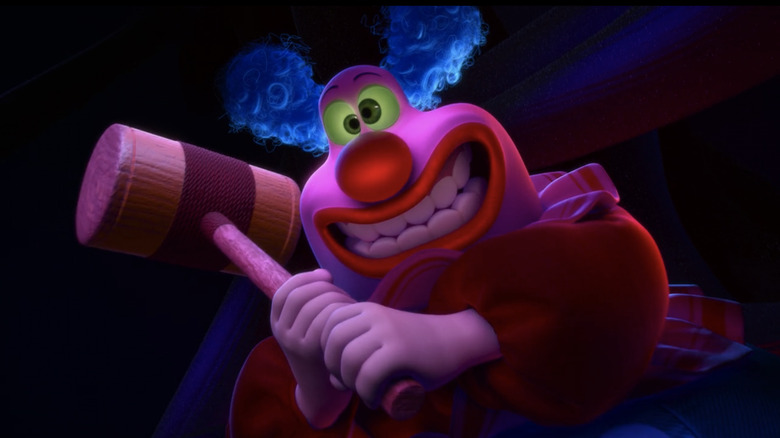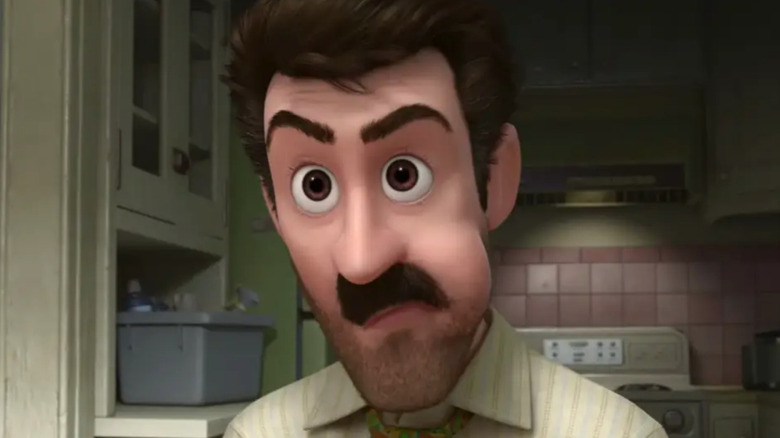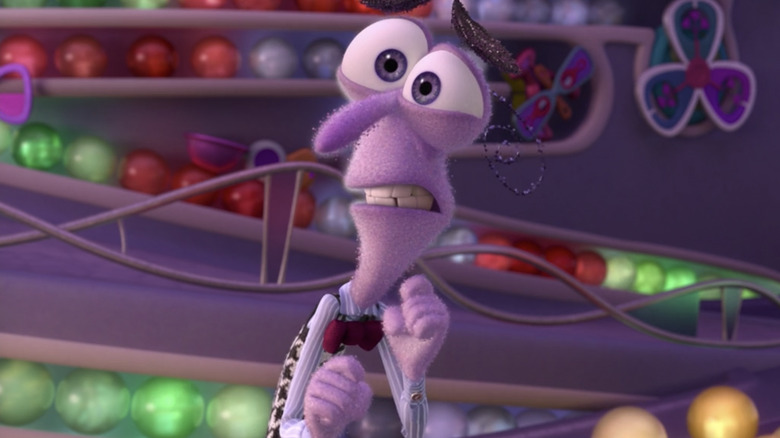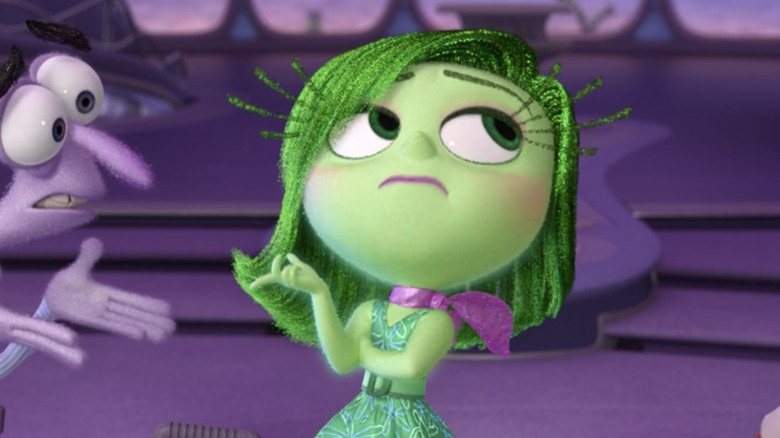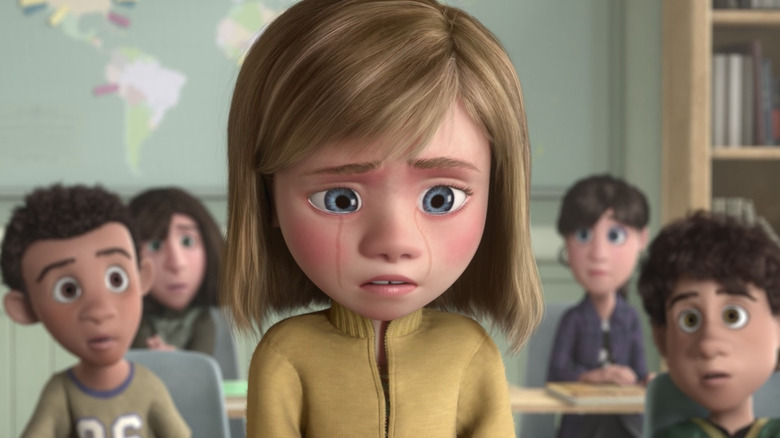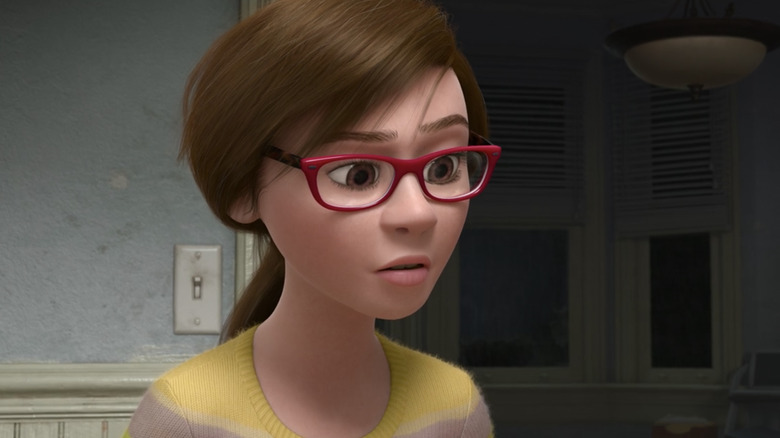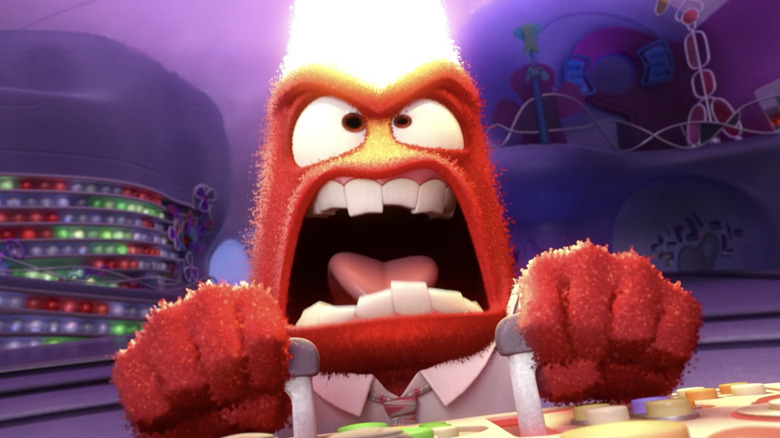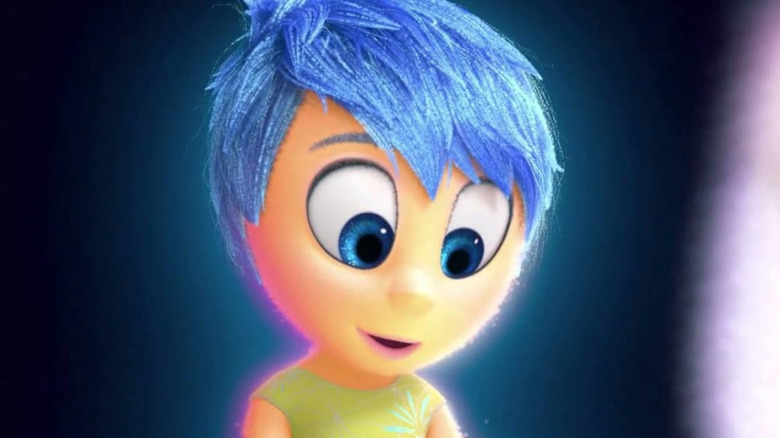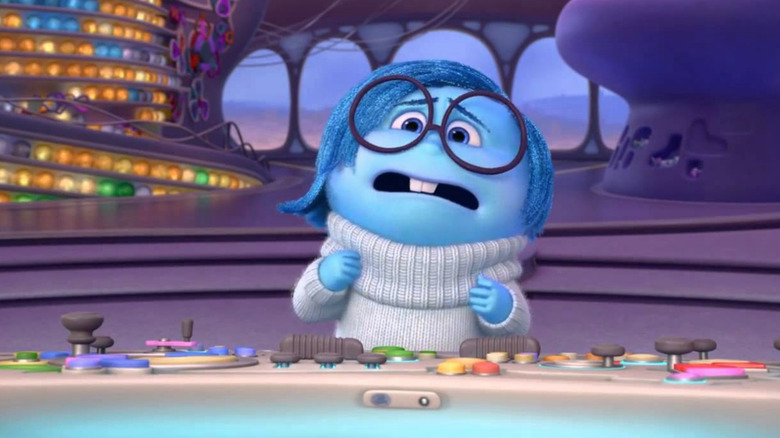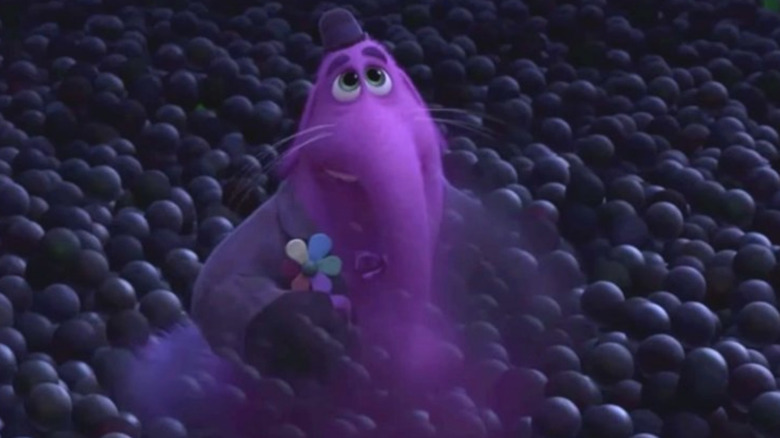10 Most Popular Inside Out Characters Ranked Worst To Best
Pixar's 2015 animated comedy "Inside Out" is one of the studio's most cleverly developed stories. Most of the plot takes place inside the mind of 11-year-old Riley Anderson, a girl whose family moves from Minnesota to San Francisco for her dad's new job. Inside Riley's head live Joy, Sadness, Fear, Disgust, and Anger — anthropomorphic emotions that help Riley navigate her world and, eventually, grow up.
But not all of the emotions work well together. Joy, the first emotion to come into existence inside Riley's mind, can be bossy, leading to the ostracization of the others, particularly Sadness, whom Joy finds useless. When Joy and Sadness eventually get booted out of the main Headquarters of Riley's mind in a freak accident, they must navigate their way through Riley's subconscious in order to get back, and with just Anger, Fear, and Disgust in charge, Riley revolts, putting her family's move in jeopardy.
How the five emotions combine to create one fully-functional person is part of the drama of the film, and there are other characters, both within Riley's head and outside of it, who contribute to the quest — or stand in its way. Here are the top ten characters from "Inside Out," ranked worst to best.
10. Jangles the clown
Seriously, who isn't afraid of clowns? When Bing Bong is captured by Riley's subconscious, Joy and Sadness go after him, venturing into the cavernous area where she keeps her worst fears. Once there, the two emotions discover a sleeping Jangles the Clown. In reality, Jangles was a professional clown — or rather, a disgruntled man who attended six years of drama school only to resort to performing as a clown for children's birthday parties. His appearance at Riley's third birthday traumatized her and made her scared of clowns forever.
Joy and Sadness need Riley to wake up so the Train of Thought can take them back to Headquarters, and the best possible way is to tap into her biggest fears. In this case, waking up the massive and monstrous clown and telling him about a birthday party they're having. Creepy, blue-haired, white-faced Jangles gets so excited about the party he starts smashing his way through the subconscious, frightening Riley so much that she pops awake.
Jangles is seriously creepy and not a character we want to revisit, though we do feel a little bad for the drama school clown. It must be hard performing for 3-year-olds.
9. Dad
Bill Anderson, aka Riley's dad (Kyle MacLachlan) doesn't seem to be trying his best. Sure, he took Riley skating and played hockey with her back in Minnesota. Sure, he makes the most out of their dinosaur car incident. But Riley's dad honestly needs to step up his game. First off, he shouldn't work so much. Part of the reason Riley gets so upset is that her dad seems to be ignoring everything going on in their family and how hard the whole transition from Minnesota to San Francisco has been for her. He's constantly on the phone, away for meetings, and generally bailing.
When he is around, though, he's not paying very close attention. As is shown in the movie, Dad's emotions are watching a hockey game in his head while Mom is trying to connect with Riley over dinner. When he finally realizes something is happening with Riley, he repeats tactics Mom has already tried, then blows up at Riley thanks to his own Anger leading things inside his head. Time to try harder, Bill.
8. Fear
Fear, voiced by the hilarious Bill Hader, is a great character in "Inside Out," and we love watching him squirm and shriek. His big eyes, lanky purple body, and nerdy persona, accentuated with a houndstooth sweater vest and bright red bowtie, can be really lovable sometimes. But Fear also has a tendency to get in the way of Riley's emotional development. Sure, it's natural to be afraid of things, and sometimes fear is a way of keeping us safe. But Fear's unwillingness to try anything new, talk to people, or experience their new home town prevents Riley from having a smooth transition.
When Riley is stuck with Fear, Disgust, and Anger, the three of them combined make for a not-so-great team, and Riley goes downhill. Fear takes over the part of Riley that would otherwise tell her to be brave in a new place and seek out new friends — his need to keep Riley safe is understandable (it's his job) but he needs to tone it down a little bit and allow Riley the opportunity to find courage in the face of adversity.
7. Disgust
Disgust (Mindy Kaling) is bit of a duality. We love her bright green look, her sense of style, her sassy attitude, and her ability to make Anger lose his cool. But Disgust adheres a little too much to social rules that serve no purpose but to make Riley a nervous wreck. When Riley starts at a new school, Disgust keeps her from even trying to make new friends, limiting her to what's "cool" or not and giving in to a ton of peer pressure. As a kid, these conventions might seem important, but adults know that the social pressures of middle school are largely nonsense.
Disgust also doesn't help Riley try new things (broccoli on pizza, for example, though in this case she might be justified) and she and Fear work in combination to bring out Riley's more stubborn attributes, as is evident when the two of them are left alone with Anger in Riley's head.
6. Riley
Smack in the middle of this list is our girl, Riley (Kaitlyn Dias). She's having a tough time, moving from Minnesota to San Francisco, having to get used to a new house (which is kind of gross with all the dead mice) and having to start at a new school. So we've got to cut her some slack here. Riley is a genuinely good kid, with an intense love of hockey, a goofy attitude, and a healthy relationship with her parents. But she's going through some really difficult emotions in "Inside Out" — not to mention that she's right on the cusp of puberty, making it practically impossible to regulate her feelings.
So when she loses Joy and Sadness in one dramatic swoop, it's sad to see what Riley becomes when she's left with just Anger, Fear, and Disgust. Becoming an adult can often feel like we have no joy left, that we've lost that childhood spark and love for anything and everything. Thankfully, Riley is able to pull herself out of her funk when Joy and Sadness return, and she learns a bit more about how all of her emotions work together.
5. Mom
Moms hold it all together, and Riley's mom, Jill Anderson (Diane Lane) is practically a smear of glue. Not only does she go along with uprooting her and her daughter's entire lives for the sake of her husband's new job, she does so enthusiastically and is obviously on the ball when it comes to things like road trip stopovers or moving companies that don't do their jobs. Mom's instincts also kick in as soon as she senses something is up with Riley. Without Joy, Riley begins to act out at the dinner table, and Mom tries to cue in Dad to help out. If only Dad was at Mom's level.
Sure, it's a bit depressing that Mom's lead emotion is Sadness, and sure, she was a little unobservant when Riley swiped her credit card from her purse right in front of her face. But Mom is on top of it when she figures out something is wrong. We just hope she got some quality time with that Brazilian helicopter pilot before settling down with Mr. Anderson.
4. Anger
Anger is definitely the funniest character in "Inside Out." Voiced by perpetually angry comic Louis Black, Anger is the only emotion that doesn't have any hair, probably due to the fact that giant flames shoot out of the top of his head when he gets mad. For some reason, he's dressed like he's going into the office, but we suppose the idea of corporate culture would make anyone enraged.
While all of the characters and emotions of "Inside Out" are hilarious in their own way, Anger really is the movie's quintessential comic relief. Black's sarcasm and scratchy voice combined with the character's stout stature and hilarious one-liners create an emotion we love. Anger doesn't make great decisions while Joy and Sadness are away (Riley running away from home is his idea), but overall he's a net positive as he helps Riley work through being walked over and eventually stand up for herself.
3. Joy
Joy (Amy Poheler) is one of the best characters in "Inside Out" simply because of the unbridled enthusiasm she brings to the film, and to Riley's personality. It's pretty neat that the first emotion Riley experiences is Joy, and that the emotion takes up so much of her childhood. Joy is yellow, mimicking the bright sunshine of her personality, and she dons a bright green dress and a blue pixie cut hair style. She literally glows, highlighting the luminescence of her personality.
The one thing Joy needs to work on, however, is how to let go of control. As Riley's main emotion, Joy can be bossy, especially when it comes to letting Riley feel any kind of stereotypically negative emotion, like Sadness. But her journey in "Inside Out" explores that very premise as Joy learns to and give up a little bit of her own power and let Riley experience the full emotional spectrum.
2. Sadness
The great thing about Sadness is that she's actually pretty funny. Voiced by Phyllis Smith, she has a gloomy sense of humor that complements her dour outlook on life. Between her negativity and the quippy comments she makes about basically everything, Sadness has some really great one-liners throughout the film.
Sadness sports a white turtleneck sweater, round black glasses, and a blue shoulder-length hair cut. She is visually the opposite of the tall, bright Joy, with whom she gets trapped outside of Headquarters. But during their journey together, Joy learns to back off while Sadness has a chance to let her emotion "shine" — that is, to let Riley to experience the usefulness of sadness, which can be used to tell others that she needs help or that she's not feeling quite right, or sometimes to just have a good cry. It's ok to be sad sometimes, and watching "Inside Out," we learn that lesson as much as Riley does.
1. Bing Bong
The absolute best character in "Inside Out" is Riley's imaginary friend, Bing Bong. Made of cotton candy with an elephant's head, a cat's tail, and a dolphin's bark, Bing Bong was created inside Riley's imagination when she was 3 years old. Bing Bong represents the loss of childhood — when Joy and Sadness find him, he's rescuing memories from being discarded into the Memory Dump, where they will soon turn gray and fade away forever. He tries to help Joy and Sadness get back to Headquarters on the condition that they help Riley remember him, but as Bing Bong can't read and has a toddler's perception of the world, things don't turn out that great.
The highlight of the entire film comes when Joy and Bing Bong get trapped in the Memory Dump, with Bing Bong sacrificing himself so that Joy can fly up and out on his rocket wagon. With a heartfelt "Take her to the moon for me," Bing Bong fades away from Riley's memory, her childhood truly gone forever. His death is up there with the saddest (and best) moments in Pixar history.
